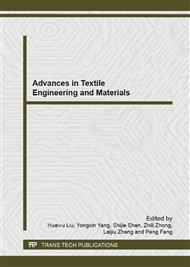p.506
p.510
p.516
p.520
p.524
p.528
p.536
p.541
p.547
Performance of Color-Harmony Models in Predicting Visual Color Harmony for Color-Apparel Images
Abstract:
Abstract. Color harmony has been systematically investigated since 1956 at Budapest using specific pattern samples with the exception of textile specimens. And, so far, there are two known color harmony models proposed by Ou et al. (abbreviated as the Ou) and Szabó et al. (as the Szabó) separately. According to the experimental results proposed by Kuo, the color harmony would be influenced by the types of sample pattern. Therefore, the performance of those two models in predicting visual color harmony for samples of fashion apparel is discussed in this study using 162 color images of fashion apparel containing 141 and 21 ones in which the fashion apparels are with two-color and three-color combinations respectively. The results indicates that the model Ou has better performance in predicting visual color harmony by the correlation coefficients 0.50 and 0.65 for the fashion apparel images with two-color and three-color combinations respectively than the Szabó 0.48 and 0.50. Meanwhile, this finding may imply that a more accurate color-harmony estimating model still needs to be developed for the fashion apparels with multiple-color combinations and it is one of the most important works of the authors in the near future.
Info:
Periodical:
Pages:
524-527
Citation:
Online since:
December 2012
Authors:
Keywords:
Price:
Сopyright:
© 2013 Trans Tech Publications Ltd. All Rights Reserved
Share:
Citation:


